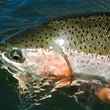The most important tool—in most cases the only tool—for saving native fish from being eaten, outcompeted or hybridized into extirpation or extinction by alien fish is the organic poison rotenone. It's derived from roots of such plants as cubé, barbasco and tuba.
But before fisheries managers recognized that fish are wildlife, too, they used rotenone to eliminate so-called "trash fish"—natives, some of which now face extinction.
For example, in 1962, when the Bureau of Reclamation impounded 91 miles of the upper Green River in Colorado, Utah and Wyoming with the Flaming Gorge Dam, managers killed Colorado pikeminnows, bonytail chubs and razorback suckers (all currently listed as endangered) to make way for four aliens—kokanee salmon, brown trout, rainbow trout and lake trout. This "benefit," cited in the project's cost-benefit analysis, was accomplished by applying rotenone to 445 miles of the Green and its tributaries.
But values (at least those of fisheries managers) have changed. Today managers use rotenone to save native fish whether or not they're pursued by anglers.
The endangered Gila topminnow would have eminently qualified as "trash" in the 1960s. Now it's being recovered by the Arizona Game and Fish Department, which uses rotenone to eradicate the species' major threat—alien mosquitofish.
The California Department of Fish and Wildlife has saved the endangered Owens pupfish, another erstwhile trash fish, from extinction by creating impounded refuges and rotenoning out alien largemouth bass, carp and bluegills.
For centuries, concentrated rotenone has been safely used by indigenous peoples to kill fish for consumption. But in modern fisheries management it's normally applied at only 50 parts per billion in running water and 100 parts per billion in stillwater. It can be neutralized downstream of treatment areas by adding potassium permanganate. One of the challenges managers face with rotenone is that it's so short-lived it can lose toxicity in one hour. Modern formulations have never been seen to permanently affect an aquatic ecosystem except to restore it.
These formulations have no effect on any air-breathing organism. Only gill-breathers are killed. There is usually some non-target mortality among aquatic insects, but most are either unaffected or, sensing the threat, detach and escape downstream via a response called "catastrophic drift." Caddisfly larvae have been seen happily feasting on dead fish minutes after treatment. Some larvae repopulate from deep within the streambed, and adults fly in from untreated water. Within weeks numbers and species are at least as abundant as before treatment and often more so because insectivorous fish they didn't evolve with have been eradicated.
Without rotenone California would no longer have its state fish, the golden trout. The species was being eliminated by alien brown trout, which outnumbered them by at least 100 to one. The father of native-fish recovery—retired California fisheries biologist Dr. Phil Pister—told me this: "I can safely say that had I been unable to use rotenone in the 1970s, the California golden trout would now be extinct."

Also headed for extinction was the rarest trout in the U.S., the Paiute cutthroat, native to only 11 miles of California's Silver King Creek in the Carson-Iceberg Wilderness of the high Sierras.
In 1949, the state inadvertently stocked rainbow trout, which promptly began hybridizing out the Paiutes.
But in 1912 a 19-year-old sheep herder, Joe Jaunsaras, had tossed Paiutes into the troutless section above impassible Llewellyn Falls. So the California Department of Fish and Wildlife, the U.S. Fish and Wildlife Service and the U.S. Forest Service had pure stock to work with.
From 2013 through 2015 they treated Silver King Creek with rotenone. Since then repeated surveys have turned up no rainbow trout or hybrid. In 2017 the recovery team moved pure Paiutes from a refuge population established outside the watershed and stocked them above Llewellyn Falls to enhance that population. Since then fish have been slipping over the falls and spreading through their traditional range, so recovery would happen naturally even if the team walked away. But this summer it plans to speed the process by stocking the mainstem. Then, for the first time in history, an imperiled freshwater fish will have been restored to 100 percent of its native range.

One might suppose that the environmental community would celebrate native-fish recovery. But more often than not it is AWOL or in shrill opposition, frightened by the word "poison."
For almost 20 years lobbying and/or litigation by groups and individuals professing to defend the environment derailed Paiute-cutthroat recovery. They cost the state and feds countless man hours, hundreds of thousands of dollars and came very close to ushering the Paiute cutthroat into oblivion.
The most passionate opponents included Wilderness Watch, Center for Biological Diversity, Pacific Rivers Council, California Watershed Alliance, Beyond Pesticides, Defenders of Wildlife, Friends of Silver King Creek, Californians for Alternatives to Toxics, insect advocate Nancy Erman, and Ann McCampbell of the Multiple Chemical Sensitivities Task Force of New Mexico, a group basically consisting of herself.
Representing some of the litigants pro bono (and shaking down defendants for attorney fees) was the Western Environmental Law Center. Rotenone, it proclaimed in a press release, "does not just kill the fish in the water but the entire ecosystem, including turtles, snakes, frogs, birds, terrestrials, insects and other animals that live in or drink from the poisoned water." Again, rotenone does not kill or even affect air-breathing organisms.

I wrote this note to the Center's Executive Director, Erik Schlenker-Goodrich: "Erik, do you stand by your press release? If so, please tell us why we should believe anything you or your outfit says. If not, please tell us why you allow your staff to publish such gross misinformation. And please tell us when the retraction and apology will be published." That was in March 2014. To date the Center has issued no retraction or apology.
Schlenker-Goodrich responded only with a rambling harangue about the Center's "good work" and an assertion that, despite my "opinion," rotenone is "controversial." I told him I held no opinion to the contrary and that the reason rotenone is controversial is because of BS dispensed by groups such as his.
In Pisces—publication of the California-Nevada Chapter of the American Fisheries Society—litigant Nancy Erman repeated the Center's fiction about rotenone. She then rebuked the Paiute recovery team and Trout Unlimited volunteers for evacuating Paiute/rainbow hybrids before treatment and moving them to "Poison Creek, the outlet of Poison Lake," thereby genetically polluting a population of pure Lahontan cutthroats. They did no such thing.
When I asked Erman for her source she offered this: "Well, we found a reference that they had been using that stream for pure Lahontans." But her reference names a Lahontan population introduced about a century ago to a different stream -- Poison Flat Creek. I requested that she publish a retraction and apology. Neither has appeared.
"Misinformation about rotenone has created challenges for us," says Clay Crowder of the Arizona Game and Fish Department. In the Coronado National Forest's Red Rock Canyon the department and Forest Service had planned to restore endangered Gila topminnows along with imperiled Gila chubs, Chiricahua leopard frogs and Sonora tiger salamanders. This meant rotenoning out an infestation of alien mosquitofish, largemouth bass and green sunfish.
But here, as elsewhere in the nation, superstitions about rotenone are rife. In 2008 the Forest Service cancelled the plan when a blogger whipped up locals to a froth of fear and loathing with memes he'd Googled up about how rotenone supposedly "puts other species at risk," "persists in the environment" and is "linked to Parkinson's disease." The Parkinson’s myth is invariably the first thing cited by rotenone opponents. It derives from a successful Emory University study in which researchers sought to create Parkinson’s-like symptoms, not Parkinson’s, by mainlining concentrated rotenone into rats’ brains via implanted pumps. At the end of five weeks no rat had Parkinson’s disease. They did have Parkinson’s-like symptoms, i.e., tremors.
The Arizona Game and Fish Commission, comprised of non-biologists, responded to the local hysteria by imposing a 16-month moratorium on all rotenone use in the state. And it convened an independent "advisory committee" to conduct a lengthy and redundant study of everything already known about rotenone. The study confirmed that fish-management formulations are perfectly safe for humans and wildlife.
That didn't stop state legislators from passing a bill requiring the department to jump through all manner of expensive and time-consuming hoops before it can use rotenone—analyses, environmental reviews, hearings and presentations. Seven years after the advisory committee gave rotenone a clean bill of health Red Rock Canyon is still infested with mosquitofish, largemouth bass and green sunfish. And there are no plans to eradicate them.
The desert-adapted Gila trout of New Mexico and Arizona has been gravely depleted by overgrazing, associated wildfire and, especially, non-indigenous trout—rainbows that hybridize with it and browns that prey on it and outcompete it.

In 2007—because of hard work by the New Mexico Department of Game and Fish, the U.S. Forest Service and the U.S. Fish and Wildlife Service—the Gila trout was downlisted from endangered to threatened, a status that allows fishing. Recovery, impossible without rotenone, is ongoing.
Rotenone has also been the most important tool for recovering desert pupfish, fluvial Arctic grayling, Maine's landlocked Arctic char, Apache trout, greenback cutthroats, westslope cutthroats, Bonneville cutthroats, Yellowstone cutthroats, Lahontan cutthroats, Colorado River cutthroats, Volcano Creek golden trout, redband trout and brook trout, to mention just a few.
Fish are featherless, furless, cold, slimy and, by people uninterested in them, unseen. So for much of the public, including some environmentalists, fish don't count as wildlife.
For example, the logo of Wilderness Watch features a rendering of a grizzly bear. The organization fights hard to preserve grizzlies and all wilderness icons, except those with fins.
Throughout the West, Wilderness Watch opposes, impedes and sometimes blocks rotenone projects. It can't imagine that native-fish recovery could be about anything other than sport. This is how it dismisses Gila trout recovery, mandated by the Endangered Species Act: "It is both sad and ironic that it was Aldo Leopold who convinced the Forest Service to protect the Gila [National Forest] as our nation's first wilderness in the 1930s—now, it is in danger of being converted to a fish farm for recreationists."
Coaching Wilderness Watch and other groups has been Ann McCampbell. For years she almost single-handedly blocked Gila trout recovery. At public hearings, between deep inhalations from behind a gas mask, she would expound on her voluminous chemical sensitivities (which, she claimed, forced her to live in a 1983 Chevy) and spew rhetoric about how rotenone would poison the Southwest.
State bureaucrats including Peter Pino, a New Mexico Game and Fish commissioner, believed her. Early in the battle Pino cast a deciding vote against rotenone use. "What if we came up with a poison that killed all the white people and left all the native people here?" he demanded. "Would we like that? I think that's what we're talking about."
"The use of poison is not in keeping with the ethics of wilderness protection," proclaims Allyson Siwik, executive director of the Gila Conservation Coalition. But keeping all the parts of wilderness is essential for its protection, and the Wilderness Act provides for precisely this kind of hands-on management.
On March 29, 2016 the Sante Fe New Mexican recycled every wives' tale ever spun about rotenone. It even hatched two new ones—that rotenone is handy for human suicide and that it's not just "linked" to Parkinson's disease but "enables" it.
In his letter to the editor John Pittenger, an aquatic ecologist with 25 years of experience in native-fish recovery, wrote: "This is like saying that sprinkling bleach (concentrated chlorine) on your breakfast cereal every day is the same as drinking tap water (treated with low concentrations of chlorine that dissipate by the time you drink it)… The story's allusion to a single case of rotenone used to commit suicide is alarmist and irresponsible. The cited suicide case involved a 47-year-old woman who deliberately ingested about 7 ounces of an 800 parts-per-million rotenone solution. Any number of household products could have been used to achieve the same unfortunate result."
When California used rotenone to protect the endangered chinook salmon and steelhead of the San Joaquin and Sacramento River systems from pike illegally stocked in Lake Davis, watershed residents rebelled. They held protest marches and all-night candlelight vigils. "Burn in Hell, Fish & Game!" read placards. Protesters shouted "Shame Shame"; others wept; others cursed; still others swam out and chained themselves to buoys. For crowd control the state brought in 270 agents consisting of highway patrolmen, sheriff's deputies, game wardens, fisheries biologists and fisheries technicians. A SWAT team deployed atop a water tank.
McCampbell was in full cry, untruthfully telling the media that rotenone fumes were sending people to the hospital.
That was in 1997. Soon thereafter Lake Davis became reinfested with pike, possibly the result of more illegal stocking by protestors or anglers or both. But a second rotenone treatment in 2007 was successful.
Fish also don't count as wildlife for a large element of anglers for whom "a trout is a trout" no matter how badly introgressed with another species.
Typical of posts on the blog I used to administer for Fly Rod & Reel magazine was this from avid angler Robert Skowronski of Sharon, Vermont: "Re. Ted Williams' attack on 'mongrel trout': I am a mongrel of sorts myself and delight in my diversity… We Americans abhor those who seek human genetic purity! American military men and women have died and continue to die for the freedom of others oppressed by those who wish to impose the same limitations on man as you are seeking to impose on trout. One could argue that what you champion is an environmental form of 'ethnic cleansing' or the Nazi equivalent of 'racial purity.' 'Purity' is a word often used by racists, Nazis and bigots. It's very much part of the argument to restore the Paiute cutthroat trout."
I responded as follows: "Mr. Skowronski: Genetic swamping by alien rainbow trout threatens to excise our rarest and most endangered salmonid from the planet. Unless your progenitors have successfully bred with, say, chimpanzees the genetic "diversity" you delight in does not include this kind of inter-species hybridization."

When I posted a piece about Montana's effort (later successful) to make 77 miles of Cherry Creek a sanctuary for imperiled westslope cutthroats by rotenoning out introduced brook trout, rainbow trout, Yellowstone cutthroats and cuttbows, most respondents advocated preserving the extant aliens and mongrels. Fishing was already good, so why delay it by messing with a different species? They'd been educated by Outdoor Life magazine, which condemned the project with a piece loaded with rotenone mythology entitled "Playing God on Cherry Creek."
Then, without offering any corrections from biologists, the editors invited readers to vote for or against the project. Ninety-eight percent were opposed.
Accomplished angler and celebrated outdoor writer Dutch Salmon, who chairs the Gila Conservation Coalition, publicly opines that mongrels with mostly Gila-trout genes are good enough. And he urges the New Mexico Department of Game and Fish to remove alien trout by "electrofishing, rather than by the use of rotenone," an impossibility save on the tiniest streams.
Anglers have repeatedly sabotaged water reclaimed for Gila trout by illegally stocking browns and rainbows.
Since 1969, when Dr. Phil Pister held the world's total population of Owens pupfish in two buckets, anglers have continually dumped alien largemouth bass back into at least one of the refuges.

Yellowstone National Park is using rotenone to restore fluvial Arctic grayling (obtained from Montana's Big Hole River) and westslope cutthroats, both victims of alien trout. Until 2015 fluvial Arctic grayling had not been seen in the park for a century.
One might suppose that all anglers would celebrate such enlightened management, but some are vehemently opposed. For example, Jackson Hole attorney Peter Moyer, founder of the Orwellian-named Wild Trout Conservation Coalition, told me this: "I am a bit of a mongrel myself. To many of us, wild trout brought to Yellowstone by the federal government over 120 years ago are different from Burmese pythons set loose by pet owners."
In diatribes fired off to every state and federal bureaucrat he can find contact info for Moyer accuses the park of endangering human civilization and the natural world by treating streams with rotenone at 50 parts per billion. "The poison," he claims, "is highly toxic to humans and animals." As backup for this untruth he cites screeds by Ann McCampbell and Nancy Erman.
It was Yellowstone National Park—rousted to action by biologist John Varley—that imposed catch-and-release for native Yellowstone cutthroats in 1973. "This was more controversial than wolf reintroduction," he says.
Guides, outfitters and anglers were apoplectic. Hook-and-bullet writers accused the agency of plotting to ban all fishing. State game-and-fish officials chanted the mantra they'd learned from older game-and-fish officials: "You can't stockpile fish."
But the park's native-fish populations exploded, refueling everything from otters to herons to white pelicans to eagles to grizzly bears.
This was the first major recognition by state or federal managers that fish are wildlife, too.
Other resource agencies can elect not to use rotenone to save native fish. The National Park Service, with a different mandate, cannot. Its Organic Act directs it to "conserve the scenery and the natural and historic objects and wildlife therein . . . leave[ing] them unimpaired."
That law should be the nation's.
This is Part I of Chemophobia in America. You can read Part II here.































Comments
jim replied on Permalink
1st visited YNP in 1993. tent camped at Madison Junction Campground. 1st thing i did was walk to the river [thought it was the Firehole]. had made a few casts when a fish shot up from the bottom and swallowed my fly. that fish was a male Grayling! a Ranger came by and asked if i had any luck. when i told him of my catch, he said it was pretty rare. also told me i was in the Gibbon River. took no photo. didn’t know it was a big deal until the Ranger came by.
Edward F Williams replied on Permalink
I caught one there, too -- in 1991. These fish came down from Grebe Lake. They were adfluvial grayling (lake dwellers), not fluvial (running-water dwellers). In Montana adfluvial grayling have occasionally been seen to become fluvial, causing debate about whether there’s really a difference. I believe there is a difference, and most fisheries biologists agree with me. That’s why the park was so enthused about bringing in fluvial grayling from the Big Hole.
Best,
Ted
John Wallace replied on Permalink
It is difficult to succeed or even to be heard out when addressing complex questions with complex answers and complex justifications. I am sorry so many are excluded from meaningful dialogue because or ego, impatience, and the inability to reserve judgment. But, on the other hand, drinking a beer with someone unfraid to read the footnotes is a fine, fine thing.
Cindy replied on Permalink
What I conclude from your article is the problem is not chemicals. It's humans. First we decide certain fish are worthwhile. Then future generations decide they are not and have to be eliminated for one reason or another. Further in the future others will make different decisions. Fish have survived without our meddling for eons. Can't we learn from the past meddling that we have made things worse? It's a slippery slope.
Edward F Williams replied on Permalink
Cindy, you have arrived at the wrong conclusion. But you have one thing right: The problem with rotenone use (that is, the impeding of its use) is not the chemical; it is humans -- human stupidity, hubris and ecological illiteracy. Fisheries managers have learned what fish are and aren’t “worthwhile.” They will not “make different decisions” in the future. Native fish in their native water are worthwhile, part of natural beauty and biodiversity. Alien fish that have been superimposed on these natives are not “worthwhile”; in fact, they need to be removed because they eliminate the worthwhile natives. Fish are wildlife just as much as timber wolves, grizzly bears and bald eagles are wildlife. Restoring native fish and the aquatic ecosystems they are part of is not “meddling.” It is correcting past meddling.
Best,
Ted
Bryce Nielson replied on Permalink
As a fisheries biologist for Utah Wildlife Resources for 35 years, I used rotenone many times. We used to drink from treated water to show nay sayers it was safe. Our recovery efforts have resulted in countless hours of fishing and the restoration of the Bonneville cutthroat. For someone to oppose its use because they are part "mongrel" makes for news headlines but is irrelevant to fish recovery programs. Biologists need to be aggressive in challenging the rotenone myth. They just can't remain silent biologists afraid of the media. The lay public listens to the loudest voice, true or not. By aggressive education of the public and media information about the positive benefits, we can still use rotenone in Utah.
Edward F Williams replied on Permalink
Thanks Bryce:
I was there when you guys restored Bonneville cutts to Strawberry Reservoir. What a success story! It choked me up.
Best,
Ted
RON SMITH replied on Permalink
As a trained fisheries biologist, I applaud your efforts to help restore natives fish species/subspecies!
Your sad commentary concerning those that espouse and propagate the fallacies of rotenone shows that many of our own species--a species known for its big brain--oftentimes do not use that big brain effectively--or even rationally. We can only hope that continuing to publish truthful facts (as opposed to the "alternative facts" which seem to be so popular of late) regarding the sad state of far too many of our native fishes is successful.
Nate Reilly replied on Permalink
Thanks for this article that brings needed scrutiny of the lies perpetuated by so-called conservation groups who ignore the established science in favor of fairy tales of the supposed grave threat posed by rotenone. To have any credibility, a conservation group should be science and evidence-based. I've read the fictions prepared by Wilderness Watch in their opposition to native species conservation projects that would not be possible without rotenone. They consistently ignore or misconstrue peer-reviewed science to make false claims like rotenone kills all gilled organisms, it persists for weeks instead of hours, and that this supposed long persistence poses threats to human health. It does not. I was glad to see Montana Fish, Wildlife & Parks cogently refute their ridiculous claims in a recent environmental assessment for a pilot study of rotenone toxicity and persistence in the North Fork Blackfoot River watershed. Not only did Montana Fish, Wildlife & Parks knock down Wilderness Watch's claims using an in depth and scientifically sound review of the scientific literature Wilderness Watch supplied, but they pointed out that Wilderness Watch ignored the extensive literature review presented in the environmental assessment that Wilderness Watch either did not read, or chose to ignore in favor of gross misrepresentation of established science.
I greatly value Wilderness and frequently find myself enjoying the solitude and untrammeled nature. I do not have respect for organizations that lie or are scientifically incompetent. I had been considering making a contribution to Wilderness Watch, as I am concerned about the proposed border wall and the push for use of mountain bikes in designated wilderness. I learned of Wilderness Watch from their article on Trump's border wall and its footprint through Wilderness and wildlife refuges. I'm glad I did some research before handing my donation to a group that is either scientifically incompetent, or blatantly lies.
Tara Elise replied on Permalink
Ted, I'm a bit confused by the contradictions in your article. You state, referring to rotenone, "These formulations have no effect on any air-breathing organism." However, later on you acknowledge that rats .. "did have Parkinson’s-like symptoms, i.e., tremors." Seems that rotenone did in fact have an effect on non-gilled organism, as stated in the study, rendering your earlier statements false.
Edward Williams replied on Permalink
Hi Tara: If you will read the passage again, you won't be confused. The rats did not have Parkinson's, only Parkinson-like symptoms. The rotenone was mainlined into their brains at millions of times the concentration used in fish recovery projects. The study did not aim to cause Parkinson's. Researchers merely wanted to induce symptoms that mimicked Parkinson's/
Nate Reilly replied on Permalink
Tara, the analyses prepared for rotenone projects reviews the literature in depth. I suggest you read one of these. Google the Buffalo Creek project for an environmental assessment. Ted is correct that the use of rotenone in a Parkinson’s research is a happenstance that when injected for weeks at high concentrations, along with the chemical carrier dimethyl sulfoxide (DMSO) causes Parkinson’s LIKE lesions that are useful for researching this awful disease. The role of the chemical carrier in getting rotenone past the blood brain barrier can’t be overstated. The blood brain barrier is our defense against many large molecules that may be harmful. Rotenone is a big yet fragile molecule and cannot get into the brain without the chemical carrier. DMSO is a commonly used chemical carrier in research and medicine. I have applied medication containing DMSO to cow udders, and if I get a tiny bit on my hand, within seconds I get a nasty chemical taste in my mouth. Injected directly into the bloodstream without DMSO, rotenone would be too big to cross the blood brain barrier. Ted is not making false statements. You need to do your homework.
Pages